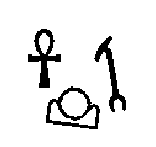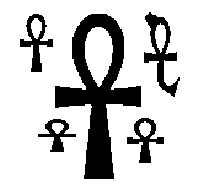K - Ancient Messages(dfs求联通块)
Time Limit:3000MS Memory Limit:0KB 64bit IO Format:%lld & %llu
Description

In order to understand early civilizations, archaeologists often study texts written in ancient languages. One such language, used in Egypt more than 3000 years ago, is based on characters called hieroglyphs. Figure C.1 shows six hieroglyphs and their names. In this problem, you will write a program to recognize these six characters.

Input
The input consists of several test cases, each of which describes an image containing one or more hieroglyphs chosen from among those shown in Figure C.1. The image is given in the form of a series of horizontal scan lines consisting of black pixels (represented by 1) and white pixels (represented by 0). In the input data, each scan line is encoded in hexadecimal notation. For example, the sequence of eight pixels 10011100 (one black pixel, followed by two white pixels, and so on) would be represented in hexadecimal notation as 9c. Only digits and lowercase letters a through f are used in the hexadecimal encoding. The first line of each test case contains two integers, H and W. H(0 < H 200) is the number of scan lines in the image. W(0 < W
200) is the number of scan lines in the image. W(0 < W 50) is the number of hexadecimal characters in each line. The next H lines contain the hexadecimal characters of the image, working from top to bottom. Input images conform to the following rules:
50) is the number of hexadecimal characters in each line. The next H lines contain the hexadecimal characters of the image, working from top to bottom. Input images conform to the following rules:
- The image contains only hieroglyphs shown in Figure C.1.
- Each image contains at least one valid hieroglyph.
- Each black pixel in the image is part of a valid hieroglyph.
- Each hieroglyph consists of a connected set of black pixels and each black pixel has at least one other black pixel on its top, bottom, left, or right side.
- The hieroglyphs do not touch and no hieroglyph is inside another hieroglyph.
- Two black pixels that touch diagonally will always have a common touching black pixel.
- The hieroglyphs may be distorted but each has a shape that is topologically equivalent to one of the symbols in Figure C.1. (Two figures are topologically equivalent if each can be transformed into the other by stretching without tearing.)
The last test case is followed by a line containing two zeros.
Output
For each test case, display its case number followed by a string
containing one character for each hieroglyph recognized in the image,
using the following code:
Ankh: A
Wedjat: J
Djed: D
Scarab: S
Was: W
Akhet: K
In each output string, print the codes in alphabetic order. Follow the format of the sample output.
The sample input contains descriptions of test cases shown in Figures
C.2 and C.3. Due to space constraints not all of the sample input can be
shown on this page.


Sample Input
100 25
0000000000000000000000000
0000000000000000000000000
...(50 lines omitted)...
00001fe0000000000007c0000
00003fe0000000000007c0000
...(44 lines omitted)...
0000000000000000000000000
0000000000000000000000000
150 38
00000000000000000000000000000000000000
00000000000000000000000000000000000000
...(75 lines omitted)...
0000000003fffffffffffffffff00000000000
0000000003fffffffffffffffff00000000000
...(69 lines omitted)...
00000000000000000000000000000000000000
00000000000000000000000000000000000000
0 0
Sample Output
Case 1: AKW
Case 2: AAAAA
#include <iostream>
#include <cstdio>
#include <cstring>
#include <cmath>
#include <algorithm>
#include <string>
#include <vector>
#include <stack>
#include <queue>
#include <set>
#include <map>
#include <list>
#include <iomanip>
#include <cstdlib>
#include <sstream>
using namespace std;
const int INF=0x5fffffff;
const double EXP=1e-;
const int maxh=;
const int maxw=*+;
int H,W;
int pic[maxh][maxw],color[maxh][maxw];
int dir[][]={{,},{,},{,-},{-,}};
char bin[][];
char line[maxw];
const char* code = "WAKJSD"; void decode(int row,int col,char c)
{
for(int i=;i<;i++)
{
pic[row][col+i]=bin[(int)c][i]-'';
}
} void dfs(int row,int col,int c)
{
color[row][col]=c;
for(int i=;i<;i++)
{
int x=row+dir[i][];
int y=col+dir[i][];
if(x>=&&x<H&&y>=&&y<W&&pic[x][y]==pic[row][col]&&color[x][y]==)
dfs(x,y,c);
}
} vector<set<int> > neighbor; void check(int row,int col) //check white
{
for(int i=;i<;i++)
{
int x=row+dir[i][];
int y=col+dir[i][];
if(x>=&&x<H&&y>=&&y<W&&pic[x][y]==&&color[x][y]!=)
neighbor[color[row][col]].insert(color[x][y]);
}
} char recognize(int c)
{
int cnt=neighbor[c].size();
return code[cnt];
} int main()
{
strcpy(bin[''], "");
strcpy(bin[''], "");
strcpy(bin[''], "");
strcpy(bin[''], "");
strcpy(bin[''], "");
strcpy(bin[''], "");
strcpy(bin[''], "");
strcpy(bin[''], "");
strcpy(bin[''], "");
strcpy(bin[''], "");
strcpy(bin['a'], "");
strcpy(bin['b'], "");
strcpy(bin['c'], "");
strcpy(bin['d'], "");
strcpy(bin['e'], "");
strcpy(bin['f'], "");
int kase=;
while(scanf("%d%d",&H,&W)==&&(H+W))
{
memset(pic,,sizeof(pic));
memset(color,,sizeof(color));
for(int i=;i<H;i++)
{
scanf("%s",line);
for(int j=;j<W;j++)
decode(i+,j*+,line[j]); //注意起始位置
}
H+=;
W=W*+;
int cnt=;
vector<int > c;
for(int i=;i<H;i++)
for(int j=;j<W;j++)
{
if(color[i][j]==)
{
dfs(i,j,++cnt);
if(pic[i][j]==)
c.push_back(cnt);
}
}
neighbor.clear();
neighbor.resize(cnt+);
for(int i=;i<H;i++)
for(int j=;j<W;j++)
{
if(pic[i][j]==)
check(i,j);
}
vector<char> ans;
int t=c.size();
for(int i=;i<t;i++)
ans.push_back(recognize(c[i]));
sort(ans.begin(),ans.end());
printf("Case %d: ",kase++);
for(int i=;i<t;i++)
printf("%c",ans[i]);
printf("\n");
}
return ;
}
K - Ancient Messages(dfs求联通块)的更多相关文章
- 利用DFS求联通块个数
/*572 - Oil Deposits ---DFS求联通块个数:从每个@出发遍历它周围的@.每次访问一个格子就给它一个联通编号,在访问之前,先检查他是否 ---已有编号,从而避免了一个格子重复访问 ...
- 【紫书】Oil Deposits UVA - 572 dfs求联通块
题意:给你一个地图,求联通块的数量. 题解: for(所有还未标记的‘@’点) 边dfs边在vis数组标记id,直到不能继续dfs. 输出id及可: ac代码: #define _CRT_SECURE ...
- 用dfs求联通块(UVa572)
一.题目 输入一个m行n列的字符矩阵,统计字符“@”组成多少个八连块.如果两个字符所在的格子相邻(横.竖.或者对角线方向),就说它们属于同一个八连块. 二.解题思路 和前面的二叉树遍历类似,图也有DF ...
- HDU - 1213 dfs求联通块or并查集
思路:给定一个无向图,判断有几个联通块. AC代码 #include <cstdio> #include <cmath> #include <algorithm> ...
- 中矿新生赛 H 璐神看岛屿【BFS/DFS求联通块/连通块区域在边界则此连通块无效】
时间限制:C/C++ 1秒,其他语言2秒空间限制:C/C++ 32768K,其他语言65536K64bit IO Format: %lld 题目描述 璐神现在有张n*m大小的地图,地图上标明了陆地(用 ...
- Educational Codeforces Round 1D 【DFS求联通块】
http://blog.csdn.net/snowy_smile/article/details/49924965 D. Igor In the Museum time limit per test ...
- POJ 1562 Oil Deposits (并查集 OR DFS求联通块)
Oil Deposits Time Limit: 1000MS Memory Limit: 10000K Total Submissions: 14628 Accepted: 7972 Des ...
- HDU1241 Oil Deposits —— DFS求连通块
题目链接:http://acm.hdu.edu.cn/showproblem.php?pid=1241 Oil Deposits Time Limit: 2000/1000 MS (Java/Othe ...
- C. Learning Languages 求联通块的个数
C. Learning Languages 1 #include <iostream> 2 #include <cstdio> 3 #include <cstring&g ...
随机推荐
- Apache Spark的部署环境的小记
Spark的单机版便于测试,同时通过SSH用Spark的内置部署脚本搭建Spark集群,使用Mesos.Yarn或者Chef来部署Spark.对于Spark在云环境中的部署,比如在EC2(基本环境和E ...
- Docker进入主流,PaaS大有可为(转)
add by zhj: 文章简单的说了PaaS所使用的传统容器的缺点,而docker这个容器在一定程度上解决了这些问题,越来越多的PaaS平台使用docker作容器,实现应用的隔离.不过,由于dock ...
- Step By Step(Lua字符串库) (转)
1. 基础字符串函数: 字符串库中有一些函数非常简单,如: 1). string.len(s) 返回字符串s的长度: 2). string.rep(s,n) 返回字符串s重复n次的结 ...
- HDU 2897 邂逅明下 (简单博弈,找规律)
邂逅明下 Time Limit: 2000/1000 MS (Java/Others) Memory Limit: 32768/32768 K (Java/Others)Total Submis ...
- Python字典 (dictionary)
字典dict,是Python唯一的标准mapping类型,也是内置在Python解释器中的. mapping object把一个可哈希的值(hashable value)映射到一个任意的object上 ...
- 关于Unity
14年左右的时候开始学习了Unity,一直没有时间总结一些东西,框架机制啥的都不用说了,网上到处都有,虽然Unity是脚本机制,但是熟悉编程的人只要理解透了拿面向对象的思维编码也完全没有问题,这里重新 ...
- 从scanf的学习接口设计
对大多数程序员来说scanf可以能是最熟悉,也是陌生的工具.在学习C语言时,大家一定没少用它,但是对它也知道不多.比如说,它有哪些可能的返回值?又比如怎么样才能跳过回车,读一个字符?我们可以一起来研究 ...
- (剑指Offer)面试题28:字符串的排列
题目: 输入一个字符串,打印出该字符串中字符的所有排列. 例如输入字符串abc,则打印出由字符a,b,c所能排列出来的所有字符串abc,acb,bac,bca,cab和cba. 思路: 把一个字符串看 ...
- 使用java实现持续移动的小球
原创作品,可以转载,但是请标注出处地址http://www.cnblogs.com/V1haoge/p/5559829.html 仅为自己学习作品,使用java的JFrame框架实现持续移动的小球. ...
- 解决NDK开发中Eclipse报错“Unresolved inclusion jni.h”的最终方法
http://blog.csdn.net/zhubin215130/article/details/39347873
